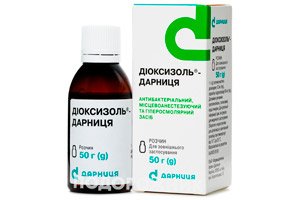
All iLive content is medically reviewed or fact checked to ensure as much factual accuracy as possible.
We have strict sourcing guidelines and only link to reputable media sites, academic research institutions and, whenever possible, medically peer reviewed studies. Note that the numbers in parentheses ([1], [2], etc.) are clickable links to these studies.
If you feel that any of our content is inaccurate, out-of-date, or otherwise questionable, please select it and press Ctrl + Enter.
Dioxysol
Last reviewed: 04.07.2025

Dioxizol is a combination drug that contains two active components: hydroxymethylquinoxylinedioxide and trimecaine. These components have an antiseptic and anesthetic effect, which makes Dioxizol useful for the treatment of various infectious and inflammatory diseases of the skin and mucous membranes.
Hydroxymethylquinoxylinedioxide has antimicrobial activity, making it effective against a wide range of microorganisms, including bacteria and some fungi. This substance is often used in medical and cosmetic products to treat and prevent infections.
Trimecaine is a local anesthetic used for pain relief. It blocks the transmission of nerve impulses in the area of application, which provides a temporary reduction in pain sensitivity in the treated area.
Dioxizol is used for the treatment and prevention of the following conditions:
- Infectious and inflammatory diseases of the skin and mucous membranes;
- Wounds, abrasions, burns - where both pain relief and infection prevention are important;
- Inflammatory diseases of the mouth and throat, such as stomatitis or tonsillitis.
Dioxysol can be presented in various forms, including solutions, sprays and ointments, which makes it convenient for different types of applications. Before use, it is important to consult a doctor who will help choose the appropriate form and dosage, as well as discuss possible side effects and precautions.
ATC classification
Active ingredients
Pharmacological group
Pharmachologic effect
Indications Dioxysol
- Treatment of superficial skin infections: Effectively used for disinfection and anesthesia of minor cuts, abrasions, burns, as well as for the treatment of pyoderma and other bacterial skin infections.
- Treatment of mucous membrane infections: Used to treat and relieve pain in inflammatory processes in the oral cavity, such as stomatitis, gingivitis, as well as inflammatory diseases of the throat, including pharyngitis and tonsillitis.
- Application in gynecology and urology: Dioxizol can be used to treat inflammatory diseases in the field of gynecology and urology, where antiseptic and analgesic action is required.
- Treatment of post-operative wounds and burns: Helps prevent infection and relieve pain during the recovery period after surgery.
Release form
It is usually available as a solution that is applied topically to the affected area or mucous membrane.
If Dioxyzole is released in the form of an aerosol for local and external use, this means that it is presented in the form of a spray or aerosol spray, which is usually used for topical application to the skin or mucous membranes.
A spray or aerosol can provide a more even and easier application of the drug to the area being treated, which can be especially convenient when treating wounds, ulcers, cuts or other superficial damage to the skin or mucous membranes.
Dosing and administration
Usually, Dioxizol is applied locally to treat purulent wounds in the form of a solution or ointment. Here are general recommendations for use and dosage:
- Wound preparation: Before applying Dioxizol, it is necessary to thoroughly clean and treat the purulent wound. This can be done with an antiseptic solution (e.g. chlorhexidine), washing the wound with a saline solution, or as recommended by a doctor.
- Application of Dioxizol: After the wound has been cleaned, Dioxizol can be applied to the affected area. For this purpose, you can use a gauze pad soaked in the solution or apply a thin layer of ointment to the surface of the wound. Dosage and frequency of application may vary depending on the severity and nature of the wound, as well as the doctor's recommendations.
- Dressing: Depending on the condition of the wound and the doctor's recommendations, after applying Dioxizol the wound can be dressed to provide protection and maintain cleanliness.
Contraindications
- Allergy to hydroxymethylquinoxylinedioxide, trimecaine or any other component of the drug. Allergic reactions may manifest as skin rashes, itching, swelling or even anaphylactic shock.
- Deep or heavily contaminated wounds. Applying antiseptics and anesthetics to deep or heavily contaminated wounds may not provide sufficient healing and may mask the symptoms of infection.
- Severe liver or kidney dysfunction. Since the components of the drug are metabolized and excreted through the liver and kidneys, dysfunction of these organs may lead to increased toxicity.
- Oral administration. Dioxizol is intended for external use only.
Side effects Dioxysol
- Allergic reactions: Like any other medicine, Dioxyzole may cause allergic reactions, which may manifest as skin rash, itching, redness or swelling at the site of application. In rare cases, more serious reactions, such as anaphylaxis, are possible.
- Local reactions: When applied externally, local reactions such as redness, burning or irritation of the skin at the site of application may occur. These reactions are usually mild and resolve spontaneously.
- Systemic effects: Although less likely, systemic effects may occur if the product is applied to large areas of skin or to damaged skin, which may result in greater absorption of the active ingredients.
Attention!
To simplify the perception of information, this instruction for use of the drug "Dioxysol" translated and presented in a special form on the basis of the official instructions for medical use of the drug. Before use read the annotation that came directly to medicines.
Description provided for informational purposes and is not a guide to self-healing. The need for this drug, the purpose of the treatment regimen, methods and dose of the drug is determined solely by the attending physician. Self-medication is dangerous for your health.
